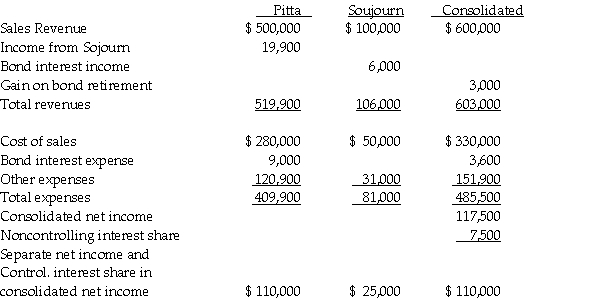Separate company and consolidated income statements for Pitta and Sojourn Corporations for the year ended December 31,2013 are summarized as follows: 
The interest income and expense eliminations relate to a $100,000,9% bond issue that was issued at par value and matures on January 1,2018.On January 2,2013,a portion of the bonds was purchased and constructively retired.
Required: Answer the following questions.
1.Which company is the issuing affiliate of the bonds payable?
2.What is the gain or loss from the constructive retirement of the bonds payable that is reported on the consolidated income statement for 2013?
3.What portion of the bonds payable is held by nonaffiliates at December 31,2013?
4.Is Sojourn a wholly-owned subsidiary? If not,what percentage does Pitta own?
5.Does the purchasing affiliate use straight-line or effective interest amortization?
6.Explain the calculation of Pitta's $19,900 income from Sojourn.
Definitions:
Poisson Arrivals
A statistical distribution that models the number of events occurring in a fixed interval of time or space, assuming independence among arrivals.
FIFO Discipline
First In, First Out Discipline is a queue management principle where the first item or task to arrive is the first to be processed or completed.
Normal Curve
A bell-shaped curve that represents the distribution of many types of data where most of the occurrences take place around the average.
M/M/1 Model
is a type of queueing model used in operations research to describe systems with a single server, where arrivals are determined by a Poisson process and service times have an exponential distribution.
Q9: Match each of the following descriptions with
Q18: Puddle Corporation acquired all the voting stock
Q20: Journalize the following utility transactions in the
Q22: Gonne Corporation is being liquidated under Chapter
Q31: PreBuild Manufacturing acquired 100% of Shoding Industries
Q31: What is a tax imposed by a
Q36: Refer to Table 19.6.All of the following
Q48: Refer to Table 19.5.<br>a.Which person has an
Q78: Refer to Table 19.6.With trade,what is the
Q98: Which of the following is a source